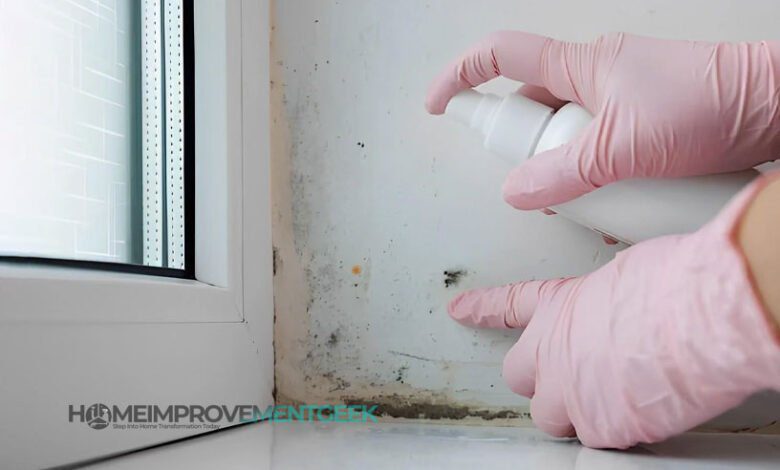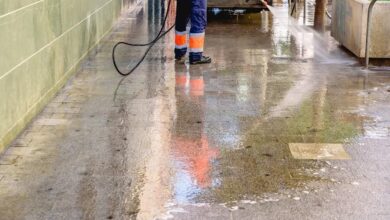How to Eliminate Airborne Mold Spores: A Comprehensive Guide

Mold spores are ubiquitous in our environment, both indoors and outdoors. While some mold spores are harmless, others can pose significant health risks, particularly for individuals with allergies, asthma, or weakened immune systems. Airborne mold spores can cause a variety of respiratory issues, including coughing, wheezing, and shortness of breath. They can also exacerbate existing medical conditions, such as asthma and allergies.
Eliminating airborne mold spores from your home or workplace is crucial for maintaining a healthy indoor environment.
This comprehensive guide will provide you with step-by-step instructions on how to effectively remove mold spores from the air, ensuring a healthier and more comfortable living or working space.
Understanding Airborne Mold Spores
Before we dive into the methods of eliminating airborne mold spores, it’s important to understand what they are and how they can affect your health. Mold spores are microscopic particles that are released by mold colonies as a means of reproduction. These spores are extremely lightweight and can easily become airborne. Once in the air, they can travel long distances and settle on various surfaces, including furniture, walls, and even clothing.
When airborne mold spores are inhaled, they can cause a range of health issues, especially for individuals with allergies or respiratory conditions. Common symptoms include coughing, sneezing, itchy eyes, and respiratory irritation. Prolonged exposure to mold spores can even lead to more severe health problems, such as asthma attacks and respiratory infections.
Effects of Inhaling Airborne Mold Spores
Inhaling airborne mold spores can have various long-term effects on health, ranging from mild to severe. It’s crucial to be aware of these potential consequences. Let’s explore the lasting impacts of exposure to mold spores:
- Respiratory Issues: Prolonged exposure to mold spores can lead to chronic respiratory problems, including persistent coughing, wheezing, and difficulty breathing. Individuals with pre-existing respiratory conditions may experience exacerbated symptoms.
- Allergic Reactions: Mold spores are known allergens, triggering allergic responses in susceptible individuals. Long-term exposure may result in the development of mold allergies, leading to sneezing, nasal congestion, itchy eyes, and skin irritation.
- Asthma Exacerbation: For those with asthma, inhaling mold spores can worsen asthma symptoms and contribute to more frequent and severe asthma attacks. Managing indoor air quality is crucial for individuals with asthma.
- Sinus Infections: Mold exposure may increase the risk of chronic sinusitis, characterized by inflammation of the sinuses. Recurrent sinus infections can be a long-term consequence of prolonged mold exposure.
- Fungal Infections: In some cases, long-term exposure to mold spores can lead to fungal infections in the respiratory system. This is more common in individuals with weakened immune systems.
- Fatigue and Weakness: Chronic mold exposure may contribute to persistent fatigue and weakness. This can impact overall well-being and daily functioning.
- Neurological Symptoms: While less common, some studies suggest a potential link between mold exposure and neurological symptoms. These may include headaches, difficulty concentrating, and memory issues.
- Skin Rashes: Skin reactions, such as rashes and irritation, can occur as a result of prolonged contact with mold spores. This is more likely in cases of direct skin contact or if mold-contaminated materials are present.
To mitigate the long-term effects of inhaling mold spores, it’s essential to address the underlying cause of mold growth and take steps to remediate it. This may involve improving ventilation, reducing humidity levels, and properly repairing water leaks or damage.
Regular cleaning and maintenance, especially in areas prone to mold growth, can significantly reduce the risk of exposure. If individuals experience persistent health issues related to mold exposure, seeking medical advice is crucial for proper diagnosis and management.
Identifying and Addressing Mold Sources
The first step in eliminating airborne mold spores is to identify and address the sources of mold growth. Common areas where mold tends to thrive include:
- Bathrooms: Due to high humidity levels and poor ventilation, bathrooms are prime breeding grounds for mold. Check for mold growth around shower curtains, shower heads, and bathroom tiles.
- Kitchens: Food spills and moisture from cooking can create a conducive environment for mold growth. Inspect areas around sinks, countertops, and refrigerators for signs of mold.
- Basements and Crawl Spaces: These areas are often damp and poorly ventilated, making them susceptible to mold growth. Check for mold on walls, floors, and exposed pipes.
- Attics: Poor insulation and ventilation can lead to condensation and mold growth in attics. Inspect for mold on rafters, insulation, and roof sheathing.
Once you have identified the sources of mold growth, take steps to address them promptly. Clean and disinfect affected areas using a mold-killing solution. Repair any leaks or moisture problems contributing to mold growth. Improve ventilation by opening windows and doors or installing exhaust fans in affected areas.
Effective Methods to Eliminate Airborne Mold Spores
Now that we have a better understanding of airborne mold spores and the importance of addressing the source of mold growth let’s delve into some effective methods to eliminate these spores from your indoor environment.
Improve Ventilation
Proper ventilation is key to reducing mold growth and eliminating airborne mold spores. Ensure that your home is well-ventilated by opening windows, using exhaust fans in bathrooms and kitchens, and installing a whole-house ventilation system if necessary. By increasing air circulation, you can help remove mold spores from the air and prevent them from settling on surfaces.
Use Air Purifiers
Air purifiers with HEPA (High-Efficiency Particulate Air) filters are highly effective in capturing and removing airborne mold spores. These filters are designed to trap even the tiniest particles, including mold spores, ensuring cleaner and healthier air in your home. Place air purifiers in rooms where mold growth is a concern, or consider using a whole-house air purifier for comprehensive coverage.
Clean and Disinfect
Regular cleaning and disinfection are essential for keeping mold spores at bay. Use a mixture of water and detergent to clean surfaces that may have come into contact with mold spores. Additionally, consider using a mold-specific cleaner or a solution of bleach and water to disinfect affected areas. Remember to wear protective gear, such as gloves and a mask, to minimize your exposure to mold spores during the cleaning process.
Maintain Optimal Humidity Levels
Mold thrives in high-humidity environments, so it is important to maintain optimal humidity levels in your home. The ideal range is between 30% and 50%. Use a dehumidifier in areas that tend to be more humid, such as basements and bathrooms, to remove excess moisture from the air. Additionally, ensure that your home is properly insulated to prevent condensation and moisture buildup.
Fix Water Leaks and Moisture Issues
Water leaks and moisture issues are a breeding ground for mold growth. Inspect your home for any signs of leaks, such as water stains or dampness, and address them promptly. Repair any plumbing leaks, fix roof leaks, and ensure that your gutters are functioning properly to prevent water from seeping into your home. By eliminating the source of moisture, you can effectively prevent mold growth and the release of airborne mold spores.
Preventive Measures to Minimize Mold Growth and Spore Dispersal
In addition to removing airborne mold spores, it’s essential to take preventive measures to minimize mold growth and spore dispersal in your home or workplace. Here are some tips:
- Control Moisture: Address any sources of moisture, such as leaks, condensation, and high humidity. Fix leaky faucets, repair damaged pipes, and use exhaust fans in moisture-prone areas to prevent mold growth.
- Maintain Proper Ventilation: Ensure adequate ventilation throughout your home or workplace by opening windows and doors regularly. Use exhaust fans in kitchens, bathrooms, and other moisture-prone areas to remove excess moisture and prevent mold growth.
- Clean and Disinfect Regularly: Regularly clean and disinfect surfaces that may harbor mold spores, such as countertops, floors, and furniture. Use a mold-killing cleaner or a mixture of bleach and water to remove mold spores effectively.
- Inspect and Repair: Regularly inspect your home or workplace for signs of mold growth. If you find mold, clean and disinfect the affected area immediately. Repair any leaks or moisture problems contributing to mold growth.
Conclusion
By following the steps outlined in this comprehensive guide, you can effectively eliminate airborne mold spores from your home or workplace, creating a healthier and more comfortable indoor environment. Remember to address the sources of mold growth, implement effective mold spore removal techniques, and take preventive measures to minimize mold growth and spore dispersal. By doing so, you can significantly reduce the risk of mold-related health issues and ensure a healthier living or working space for yourself and others.
FAQs
Can mold spores be eliminated from the air?
While it is not possible to eliminate all mold spores from the air, you can significantly reduce their presence by implementing proper ventilation, using air purifiers, and maintaining a clean and dry indoor environment.
Are all types of mold spores harmful to health?
Not all types of mold spores are harmful to health. However, certain types of mold, such as black mold (Stachybotrys chartarum), can produce toxins that can have adverse effects on human health. It is important to address any mold growth and eliminate airborne mold spores to minimize the risk of health problems.
Can I remove mold spores by simply wiping surfaces with a cloth?
Wiping surfaces with a cloth may remove some mold spores, but it is not a comprehensive solution. Mold spores can be easily disturbed and become airborne, leading to further contamination. It is recommended to use a mixture of water and detergent or a mold-specific cleaner to clean surfaces, followed by disinfection with a bleach and water solution.
How often should I clean and disinfect to prevent airborne mold spores?
Regular cleaning and disinfection are important to prevent mold growth and eliminate airborne mold spores. The frequency of cleaning will depend on the specific conditions in your home. However, it is generally recommended to clean surfaces at least once a week and address any visible mold growth immediately.
Can professional mold remediation help eliminate airborne mold spores?
Yes, professional mold remediation can be highly effective in eliminating airborne mold spores. Certified mold remediation specialists have the knowledge, experience, and equipment to safely and effectively remove mold and prevent its recurrence. If you have a severe mold problem or are unable to eliminate airborne mold spores on your own, it is advisable to seek professional assistance.



